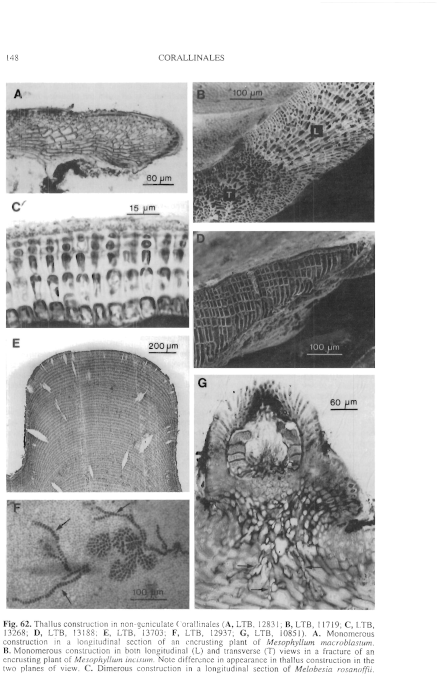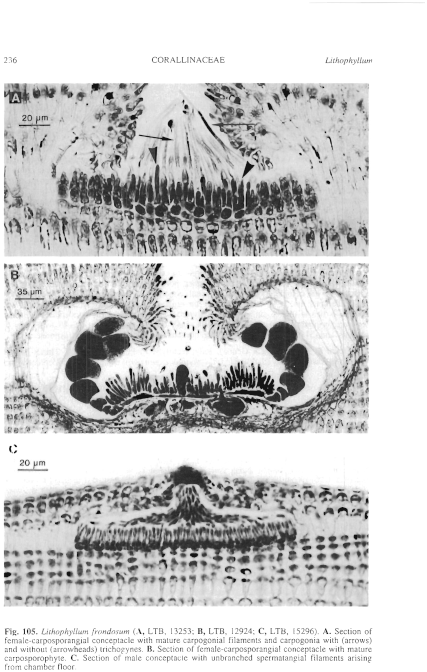|
|
|
|
|
|||||||||||
|
Electronic Flora of South Australia Species Fact Sheet
Phylum Rhodophyta – Class Florideophyceae – Order Corallinales – Family Corallinaceae – Subfamily Lithophylloideae
Synonyms
Melobesia frondosa Dufour 1861: 39. Dufour 1864: 60. Woelkerling, Penrose & Chamberlain 1993: 326, figs 12–15.
Lithophyllum bermudense Foslie & Howe 1906: (132), pl. 81 fig. 3, pl. 85 fig. 3, pl. 92. Barry & Woelkerling 1995: 137. Campbell & Woelkerling 1990: 119, fig. 13. Millar & Kraft 1993: 14. Woelkerling & Campbell 1992: 18, figs 2–15. Woelkerling 1993: 38.
Dermatolithon bermudense (Foslie & Howe) Foslie & Howe in Foslie 1909: 58.
Tenarea bermudense (Foslie & Howe) Adey 1970: 6.
Titanoderma bermudense (Foslie & Howe) Woelkerling, Chamberlain & Silva 1985: 333.
Thallus normally pinkish, encrusting to layered, foliose, warty, lumpy or fruticose, mostly 4–200 mm across and 0.1–60 mm thick or tall, partially to completely affixed by cell adhesion or unattached and free-living as rhodoliths; protuberant branches simple or branched, mostly 2–27 mm in diameter and 2–29 mm long; lamellate branches applanate or ascending and sometimes coalescent, mostly 3–12 mm across and 1–8 mm long. Structure pseudoparenchymatous, organisation dorsiventral in crustose portions and lamellate branches but radial in protuberant branches; construction dimerous, dimerous and monomerous or largely monomerous; dimerous portions consisting of a single ventral layer of branched, laterally cohering, filaments each composed of palisade and/or non-palisade cells 5–25 µm long and (16–) 25–60 (–100) µm high, and additionally of simple or branched, laterally cohering, filaments that arise dorsally and more or less perpendicularly from cells of ventral layer filaments and are each usually composed of cells 3–15 µm in diameter and (3–) 8–50 (–60) µm long; monomerous portions consisting of a single system of branched, laterally cohering, filaments that collectively contribute to a ventrally or centrally situated core and a peripheral region where portions of core filaments or their derivatives curve outwards towards the thallus surface, with each filament composed of cells 5–14 µm in diameter and 5–50 (–70) µm long; epithallial cells 4–12 µm in diameter and 2–6 µm long, terminating most filaments at the thallus surface, with distal walls rounded or flattened but not flared; cells of adjacent filaments joined by secondary pit-connections; cell-fusions, haustoria, and trichocytes unknown.
Reproduction: Vegetative reproduction by thallus fragmentation. Gametangia, carposporangia and tetrasporangia produced in uniporate conceptacles; gametangia and carposporangia formed on thalli separate to those bearing tetrasporangia. Bisporangia unknown.
Gametangial thalli probably dioecious. Carpogonia terminating 2- or 3-celled filaments arising from the female conceptacle chamber floor. Mature female-carposporangial conceptacle roofs flush with or slightly protruding above surrounding thallus surface, 65–110 µm thick, composed of 7–11 layers of cells above the chamber, conceptacle chambers (169–) 300–385 µm in diameter and (65–) 85–115 (–125) µm high. Carposporophytes composed of a conspicuous central fusion cell and several-celled gonimoblast filaments bearing terminal (rarely catenate) carposporangia 30–55 µm in diameter. Spermatangial filaments unbranched, borne in groups of 1–3 on initials across the male conceptacle chamber floor, mature male conceptacle roofs flush with or slightly protruding above surrounding thallus surface, 18–40 µm thick, composed of 4–5 layers of cells above the chamber, male conceptacle chambers (100–) 140–160 µm in diameter and 25–60 µm high.
Tetrasporangial conceptacle roofs non- or slightly protruding above surrounding surface, mostly 3–7 cells thick above chamber, pore canals lined with somewhat projecting cells that do not completely occlude the canal, conceptacle chambers (255–) 320–410 (–445) µm in diameter and (65–) 90–125 (–160) µm high, floor of mature chambers usually 7 or more cells below thallus surface; tetrasporangia scattered across the conceptacle chamber floor or peripheral to a central columella, each mature sporangium 25–45 (–55) µm in diameter and (31–) 75–125 (–135) µm long, containing zonately arranged tetraspores.
Type from St Nazzaro (near Genoa), Italy; lectotype in PC (unnumbered, Thuret-Bornet Herbarium, fascicle 132, filed under Lithophyllum expansum); designated by Woelkerling et al. 1993: 327.
Selected specimens: Eagle Bluff, Shark Bay, W. Aust., 1–2 m deep (Woelkerling, 31.vii.1986; LTB, 15482, 15486). Cape Vlaming, Rottnest I., W. Aust., reef edge (Woelkerling, 8.ii.1978; LTB, 10601, 10603, 10604, 10619). North Point Reef, Rottnest I., W. Aust., reef edge (Woelkerling, 10.ii.1978; LTB, 10664, 10668). Point Valliant, Two People Bay, W. Aust., 0–1 m deep (Woelkerling, 2.ii.1978; LTB, 10725). Twilight Cove, Eyre, W. Aust., 2–3 m deep (Woelkerling, Platt & Jones, 2.ii.1984; LTB, 14031, 14038, 14043, 14061). Eucla, W. Aust., drift (Woelkerling, 26.i. 1978; LTB, 10523). Head of Great Australian Bight, S. Aust., drift (Woelkerling, Platt & Jones, 13.ii.1984; LTB, 14381). Point Sinclair, S. Aust., reef pools (Womersley, 26.i.1951; AD, A15212 = LTB, 13636 and 8.ii.1954; AD, A19647). Point Westall, S. Aust., 2–3 m deep (Platt & Jones, 16.ii.1984; LTB, 14527, 14530, 14549). Port Lincoln (Boston I.), S. Aust., reef top (Woelkerling, 14.v.1968; AD, A32622 = LTB, 14683). Cape Willoughby, Kangaroo I., S. Aust., 0–2 m deep (Campbell & Penrose, 6.iv.1988; LTB, 15588, 15589). Beachport (Post Office Rock), S. Aust., on reef, 0–6 m deep (Campbell, Penrose & Woelkerling, 1.xii.1986; LTB, 15510; Woelkerling, 6.xi.1987; LTB, 15822; Campbell & Penrose, 26.ii.1988; LTB, 15682). Blanket Bay, Otway National Park, Vic., 2 m deep (Campbell, Penrose & May, 14.xi.1985; LTB, 15251). Anglesea (Ingoldsby Reef), Vic., upper sublittoral (Beanland, 13.xii.1982; LTB, 15295, 15296). Cape Paterson (Eagles Nest), Vic., reef top (Woelkerling, 27.xi.1976; LTB, 12510). Rocky Cape National Park, Tas., 0–1 m deep (Platt, 2.iii.1983; LTB, 13435). Eddystone Point, Tas., 0–3 m deep (Platt, 23.ii.1983; LTB, 13187, 13188, 13189, 14648). Coles Bay, Freycinet Pen., Tas., 0–2.5 m deep (Platt & Woelkerling, 21.ii.1983; LTB, 13111, 13115, 13130, 13144). Eaglehawk Neck (Clydes I.), Tas., at low tide (Platt, 26.ii.1983; LTB, 13260). Eaglehawk Neck (Tessellated Pavement), Tas., 1–2 m deep (Platt & Woelkerling, 26.ii.1983; LTB, 13241, 13243, 13253). Sister Bay (Convict Burial Ground), Southport, Tas., 3–4 m deep (Platt, 16.ii.1983; LTB, 12913, 12914, 12915, 12924, 14654). Newport, N.S.W., drift (Womersley, 30.v.1950; AD, A13077 = LTB, 14684).
Distribution: Mediterranean Sea; Bermuda; Florida; Caribbean islands; Juan Fernandez I.
In Australia, Eagle Bluff, Shark Bay, W. Aust., to Newport, N.S.W., and from the northern and eastern coasts of Tasmania.
Taxonomic notes: The type of L. bermudense, from Spanish Point, Bermuda (Howe, 21.vi.1900) is Howe 199 in TRH.
Lithophyllum frondosum has been found in southern Australia on rock, or occasionally on molluscs, algae or seagrasses or unattached; it occurs in intertidal pools and along reef edges in heavy surf and subtidally to depths of 13 m. Of the known southern Australian species of Lithophyllum, L. frondosum is the most variable morphologically and anatomically. Woelkerling & Campbell (1992, p. 97) reported that, rarely, intermediates can occur between L. frondosum (as L. bermudense) and L. corallinae and conclude that further studies of the relationships of these two species are required. Furnari et al. (1996) provide an account of this species in the Mediterranean.
References:
ADEY, W.H. (1970). A revision of the Foslie crustose coralline herbarium. K. norske Vidensk. Selsk. Skr. 1970 (1), 1–46.
BARRY, G.C. & WOELKERLING, W.J. (1995). Non-geniculate species of Corallinaceae (Corallinales, Rhodophyta) in Shark Bay, Western Australia: biodiversity, salinity tolerances and biogeographic affinities. Botanica Mar. 38, 135–149.
CAMPBELL, S.J. & WOELKERLING, W.J. (1990). Are Titanoderma and Lithophyllum (Corallinaceae, Rhodophyta) distinct genera? Phycologia 29, 114–125.
FOSLIE, M. & HOWE, M.A. (1906). New American coralline algae. Bull. N.Y. Bot. Gdn 4(13), 128–136, Plates 80–93.
FOSLIE, M. (1909). Algologiske notiser. VI. K. norske Vidensk. Selsk. Skr. 1909(2), 1–63.
FURNARI, G., CORMACI, M. & ALONGI, G. (1996). Lithophyllum frondosum (Dufour) comb. nov. (Corallinaceae, Rhodophyta), the species to which Mediterranean "Pseudolithophyllum expansum" should be referred. Eur. J. Phycol. 31, 111–116.
MILLAR, A.J.K. & KRAFT, G.T. (1993). Catalogue of Marine and Freshwater Red Algae (Rhodophyta) of New South Wales, including Lord Howe Island, South-western Pacific. Aust. Syst. Bot. 6, 1–90.
PENROSE, D. & CHAMBERLAIN, Y.M. (1993). Hydrolithon farinosum (Lamouroux) comb. nov.: implications for generic concepts in the Mastophoroideae (Corallinaceae, Rhodophyta). Phycologia 32, 295–303.
WOELKERLING, W.J. & CAMPBELL, S.J. (1992). An account of southern Australian species of Lithophyllum (Corallinaceae, Rhodophyta). Bull. Br. Mus. Nat. Hist., Bot. Ser. 22, 1–107.
WOELKERLING, Wm.J. (1993). Type collections of Corallinales (Rhodophyta) in the Foslie Herbarium (TRH). Gunneria 67, 1–289.
WOELKERLING, W.J., IRVINE, L.M. & HARVEY, A.S. (1993). Growth-forms in non-geniculate coralline red algae (Corallinales, Rhodophyta). Aust. Syst. Bot. 6, 277–293.
The Marine Benthic Flora of Southern Australia Part IIIB complete list of references.
Publication:
Womersley, H.B.S. (28 June, 1996)
The Marine Benthic Flora of Southern Australia
Rhodophyta. Part IIIB. Gracilarialse, Rhodymeniales, Corallinales and Bonnemaisoniales
Reproduced with permission from The Marine Benthic Flora of Southern Australia Part IIIB 1996, by H.B.S. Womersley. Australian Biological Resources Study, Canberra. Copyright Commonwealth of Australia.
Illustrations in Womersley Part IIIA, 1996: FIGS 62D, 63E, 104, 105.

Figure 62 enlarge
Fig. 62. Thallus construction in non-geniculate Corallinales (A, LTB, 12831; B, LTB, 11719; C, LTB, 13268; D, LTB, 13188; E, LTB, 13703; F, LTB, 12937; G, LTB, 10851). A. Monomerous construction in a longitudinal section of an encrusting plant of Mesophyllum macroblastum. B. Monomerous construction in both longitudinal (L) and transverse (T) views in a fracture of an encrusting plant of Mesophyllum incisum. Note difference in appearance in thallus construction in the two planes of view. C. Dimerous construction in a longitudinal section of Melobesia rosanoffii.

Figure 63 enlarge
Fig. 63. Cell morphology and anatomy in non-geniculate Corallinales (A, LTB, 12787; B, LTB, 15249; C, LTB, 14171; D, LTB, 15688; E, TRH, Howe no. 199; F, LTB, 14493; G, LTB, 15578). A. Section of Phymatolithon masonianum showing compressed epithallial cells (arrowheads) and vegetative initials (arrows) that are shorter than the cells immediately subtending them. B. Section of Mesophyllum printzianum showing rounded epithallial cells (arrowheads) and vegetative initials (arrows) that are as long as or longer than the cells immediately subtending them. C. Section of Sporolithon durum showing epithallial cells (arrow heads) with flared outer walls D. Palisade cells of contiguous filaments of Metamastophora flabellata showing cell-fusions (F). E. Columnar cells of Lithophyllum frondosum showing primary (arrow - p) and secondary (arrow - s) pit connections. F. Fracture of Sporolithon durum showing fusions (F) between cells of contiguous filaments. G. Fracture of Lithophyllum corallinae showing pit connections in surface (arrowhead) and sectional (arrow) views.

Figure 104 enlarge
Fig. 104. Lithophyllum frondosum (A, LTB, 14061; B, LTB, 10604; C, LTB, 13260; D, LTB, 10668; E, LTB, 13187). A. Encrusting thalli on the red alga Osmundaria. B. Warty to lumpy thalli detached from rock. C. Warty to foliose thallus on rock. D. Portion of fruticose thallus detached from rock. E. Section of mature tetrasporangial conceptacle.

Figure 105 enlarge
Fig. 105. Lithophyllum frondosum (A, LTB, 13253; B, LTB, 12924; C, LTB, 15296). A. Section of female-carposporangial conceptacle with mature carpogonial filaments and carpogonia with (arrows) and without (arrowheads) trichogynes. B. Section of female-carposporangial conceptacle with mature carposporophyte. C. Section of male conceptacle with unbranched spermatangial filaments arising from chamber floor.

|
Email Contact: State Herbarium of South Australia |

|